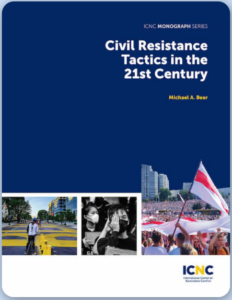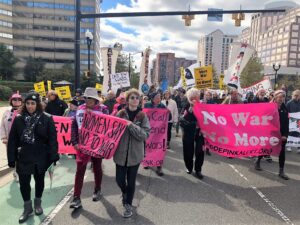Minds of the Movement
An ICNC blog on the people and power of civil resistance
by Nadine BlochFebruary 04, 2022
I first began exercising my 'activist muscle' and learning about nonviolent tactics to abolish nuclear weapons back in the 1980s. At the time, the go-to resource was Gene Sharp’s “198 Nonviolent Action Methods”, published in 1973. It was exhilarating to read about the variety of tactics that had been tried, often successfully, to win social and political change without resort to violence.
Now almost 50 years later (did I do the math right?!), I am an activist, artist, strategic organizer, and training director for BeautifulTrouble—and thrilled that 2021 brought an update to Sharp’s crucial catalog of nonviolent methods in Michael Beer’s Civil Resistance Tactics in the 21st Century (“CRT21”), published by ICNC Press.
Accounting for an explosion of new tactics

Civil Resistance Tactics in the 21st Century, by Michael A. Beer, ICNC Press, 2021. Click cover for more information.
CRT21 is more than just a huge updated list of tactics, though that is no small part of what is included. It comprises a new innovative catalog, a refined framework, and an overview of the state of civil resistance worldwide. As a compilation resource, it directly serves readers who are interested in exploring methods for strategic planning, training and research. Michael Beer’s background and personal experience shine through in the depth and breadth of the stories and tactics included: Beer has been the Director of Nonviolence International since 1998, and for decades he has been supporting activists on the ground who nonviolently resist dictatorships in support of global peace.
The 21st century has witnessed an explosion of the use of civil resistance methods by campaigns around the world, making this publication exceptionally timely. Sometimes called nonviolent resistance, unarmed struggle, or nonviolent action, this kind of people-powered action is now a mainstay for movements, as research done in 2011 documented nonviolent campaigns to be on average twice as effective as campaigns that used violent methods. In the last 10 years, however, civil resistance has become less effective, at least partly due to an over-reliance on repetitive tactics and an emphasis on expressive or symbolic rather than instrumental actions. Not to mention that authorities are getting smarter. Innovation and ability to escalate are directly linked to success rates of campaigns, and that's why the new CRT21 framework for mapping tactics supports increased campaign effectiveness.

A protester displays art at a celebratory street blockade with Biden Get a Backbone in Washington, DC, January 2022. Credit: John Nelson, SpacesInAction.
Gene Sharp was known as a “global guru of nonviolent resistance” or the “Clausewitz of nonviolent warfare” for his research and writings on strategic nonviolent action. Still, many of us practitioners and students of civil resistance have talked about updating his fabulous, though somewhat inconsistent and now outdated list of 198 Methods for years. In Beer’s new book, about 350 unique tactics are listed. Of course, in 1973, there were no digital tools included in the 198, accounting for some but not all the new tactics. Beer also identifies nine additional factors that could account for this explosion of tactical innovation and deployment, including arts-based and cultural resistance, ongoing repression, and resistance to the rise of global corporate power.
Addressing conceptual shortcomings

Biden Get a Backbone, Washington, DC, January 2022. Credit: John Nelson, SpacesInAction.
Besides exploring factors responsible for the almost doubling of documented methods, Beer goes deep into Sharp’s enduring classification typology and compares it to other ways civil resistance practitioners and scholars have attempted to overcome its few, though significant, drawbacks. As Beer points out, Sharp’s original categories—1. protest and persuasion, 2. noncooperation, and 3. intervention—have been useful in their simplicity for decades. However, Sharp’s categorization is based on equating the methods with military actions used against an adversary, which discounts some constructive action that would engage society to pull support away from an opponent or build social cohesion (education, advocacy, organization building efforts). It also doesn’t make a distinction between coercive or persuasive methods. And though there are numerous subcategories, there is inconsistency as some refer to the arena of action, some to a specific medium or material, and some to types of interventions.
These longstanding issues with Sharp’s categorizations make the “Universal framework” presented in Beer’s book very welcome. This new framework based on resistance behavior and the mechanism or the nature of the action leads to a clearer, more consistent documentation of tactics. The fact that it refines and builds on Sharp’s typology allows for a specificity that is more useful for strategic planning and analysis by experts and novices alike.
In brief, this new framework clearly identifies three categories of “resistance behaviors”:
- Acts of expression (SAYING);
- Acts of omission (NOT DOING); and
- Acts of commission (DOING or CREATING).

Vigil to the U.S. Senate offices that voted for continued weapons to Saudi Arabia. Washington, DC, October 21, 2018. Credit: Code Pink Facebook page.
Then, it acknowledges that each of these behaviors can happen in a constructive/persuasion or confrontational/coercive frame.
The subcategories for each of the above are specific and consistent:
- Saying (protest or appeal): human body, material arts, digital tech, human language;
- Not doing (noncooperation): political, social, economic; (refraining): suspending, active abstention;
- Doing/creating (disruptive or creative intervention): political/judicial, economic, social, physical, psychological.
One drawback of this new categorization is that some of the language chosen for the subcategories is not intuitive and needs definition: human body, material arts, digital tech, human language. However, I do want to acknowledge that the unease with these titles might just be from 50 years of muscle memory of using Sharp’s language, and moreover, alternative suggestions are difficult to come by.
A unique feature
The most fascinating chapter in CRT21, “On the Edges of Civil Resistance Tactics”, reviews methods that Beer excluded purposefully from the new listings, given current debates about their inclusion within the definition of nonviolent action. From “everyday resistance” to “property destruction and transformation”, these elaborations are fertile ground for further research and reflection in movement conversations worldwide.
As the world today is facing increasing inequality, authoritarianism, attacks on civil society, an historic pandemic, and a growing climate crisis, folks the world over still need this kind of resource. More broadly, we need support to be able to see, understand, and thus grapple with the huge space between feeling powerless to do something, on one side of the conflict spectrum, and on the other, resorting to—truly believing that—violence is the only viable option to produce change. Just to be crystal clear: That huge space in the middle of the spectrum is occupied by nonviolent action—and it's growing every day, because it is driven by abounding human agency.
Beer’s new civil resistance tactical framework and identification guide not only significantly contributes to our understanding of the state of the field of civil resistance practice, but it also supports effective strategic planning and training for movements seeking to transform society by harnessing people power. Beer’s book is essential reading if you are an organizer, activist, planner of nonviolent tactics or campaigns… and you want to do everything you can to up your game.

Nadine Bloch
As an activist artist, strategic nonviolent organizer, and Training Director of Beautiful Trouble, Nadine Bloch explores the potent intersection of art and people power. Find her writings in Beautiful Trouble, SNAP: An Action Guide to Synergizing Nonviolent Action and Peacebuilding, and WagingNonviolence.org.
Read More